|
GMC
Sound Pressure Level Competition Van
Sound level competition became a hobby and a personal drive
during employment at Carls Stereo on Wheels.
The van was purchase one year prior, as a rehabilitation project
and daily driver. A new
engine and interior, including seats and carpet, was installed for
reliability and personal enjoyment.
The competition conversion was initiated following a conversation
with Carl, company owner, regarding possible arrangement for an intense
product representation and competition vehicle for the companys
customers and employees. The
Installation labor and supply cost was arranged to be my responsibility.
Stereo equipment, including speakers, wire, connectors,
alternators, amplifiers, batteries, radio, and extras was provided by
Carl.
S.P.L. conversion for the van lasted more than one year; this was
a period of time requiring intense personal sacrifices and creative
personal best. The initial
steps of the process involved an intense educational process that lasted
the complete dedicated era. Different
enclosures provided a plethora of enlightening experiences.
Each new experience provided new possible creative ideas which
sometimes lead to a new enclosure design
The initial design utilized sixteen fifteen-inch MTX subwoofers,
eight MTX seven-hundred watt amplifiers, and eight yellow top Optima
batteries. The enclosure
provided an intense free air, doors open, high pressure sound vehicle. The
resonant frequency was recorded to be approximately 80Hz.
The van was entered into its first sound pressure level (S.P.L)
competition and was rewarded a first place trophy and money order of
two-hundred fifty dollars. The
van provided a pressure recording of 158 db, during the contest, off the
windshield, with the doors closed. This
experience provided an accouchement to an intense drive for the highest
sound pressure possible.
Analysis
of the first enclosure, through trial and error, provided results
regarding pressure cancellation. The
sideways V configuration in picture 1, with eight subs on each arm
of the V with four apposing the accompanying four allowed for an
efficient way to install all sixteen into the van, perpendicular to the
automobile floor. Enclosure
construction utilized medium density fiberboard (M.D.F), fiberglass
resin, and fiberglass mat. My analysis provided information that
cancellation occurs with the front eight subwoofers.
The rear eight connected individually, without the front eight
and with only 4 amplifiers, provided the same S.P.L results recorded at
the competition. I
understood that the speaker enclosure would be useless if the enclosed
space allowed for more than two speakers deep. Stopping
examination at this point would only provide a theory without proof.
|
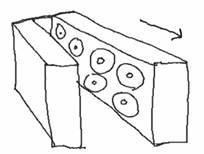
Picture
1
|
|
|
A new enclosure was the only way to provide proof for my analysis.
The second enclosure design accreted from analysis of other
competition vehicles and my personal experiences.
The new design was similar to a UU shape on its side with
four speakers on each arm of the U, perpendicular to the auto
floor. Picture 2 provides
some insight to the duel U design.
This enclosure provided enough space for sixteen subwoofers to be
installed behind the door jambs and eight amplifiers.
Each center single subwoofer had an individual enclosure, 1.5
cubic foot, for easy speaker removal.
Depth between the front of the center enclosures and the edge
enclosures was only ten inches. The
distance further provided additional problems with pressure
cancellation. Removal of the
center enclosures, provided a single wider U shape on its side,
proved to allow for a slightly higher S.P.L than the original V
enclosure due to the shorter travel distance for the reflection off of
the rear of the enclosure. The
adequate resonant frequency resulted in 80Hz, the same as the V
enclosure. Further
investigation resulted in additional information that the flat portion
of the rear of the enclosure and a wide distance between apposing
speakers provide increase reduction in sound cancellation.
The new enclosure did not provide the desired increase in sound
pressure and did not allow for the preferred amount of electronic
equipment. An additional,
third, enclosure must be designed for more equipment and pressure
increase.
|

Picture
2
|
|
|
The third enclosure design provided mounting locations for only
twelve fifteen-inch subwoofers and six amplifiers.
A U enclosure design was configured to allow the subwoofers
to be mounted above and below each other with six on the top U arm
and six on the bottom U arm, horizontally mounted to the auto
floor. The rear of the
enclosure was designed to have a flat reflective surface.
Opposing speakers had ample distance from each other and apposing
was no further than two deep. Completion
of this enclosure provided an increase in pressure recording.
Further enhancement investigation loosened hidden important
information about side to side apposing separation applied to more than
distance from the microphone. Dividing
the enclosure in to three separate U enclosures side by side
provided a decrease in sound cancellation.
The enclosure provided a recorded S.P.L. competition score of 164
db. This pressure level
allowed the vehicle to place a third position at the local S.P.L. final
competition. This enclosure
provided its highest pressure recording at 82Hz with the rear of the
enclosure located at approximately 72 inches from the microphone.
During the competition, I noticed that the first and second place
competitors provided a higher frequency to their vehicle during the
competition. I confronted
them with questions regarding their frequency analysis experience.
One of the competitors informed me that the resonant frequency
change was able to be changed with enclosure volume size.
An additional competitor allowed the information that his
competition auto can respond to individual and both 80Hz and 120Hz
frequency range. I took this
important information and analyzed every connection and configuration of
their vehicles. The
automobiles had similar enclosures with obvious pressure cancellation
issues that were experienced with my enclosures.
|
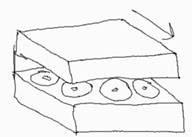
Picture
3
|
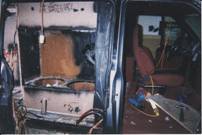
Picture
4
|
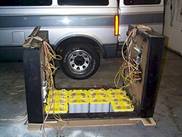
Picture
5
|
A personal drive initiated an additional enclosure with six
V shaped enclosures. Each
V shaped enclosure had only one subwoofer inverted on each arm,
horizontally mounted speaker cone to the automobile floor. The enclosure
was installed directly behind the door jambs.
The center six enclosures had useful design aspect to allow for
separate enclosure removal and speaker replacement.
Each enclosure supplied the desired 1.5 cubic-foot enclosure for
individual speakers. This
enclosure was derived from the allowance for possible decrease in
pressure cancellation due to the decrease in speaker apposition.
Pressure results decreased due to the use of 80Hz frequency
spectrum. The decrease in
S.P.L was not understood at the time.
This enclosure adsorbed a large amount of time and was not
providing desired results. My
analysis informed me that the distance from the microphone to the rear
of the enclosure must be in the range of 72 inches.
Destruction of the supposed perfect enclosure happened
prematurely.
|
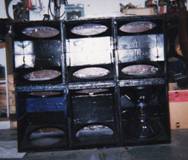
Picture
6
|

Picture
7
|
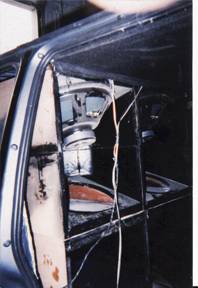
Picture
8
|
|
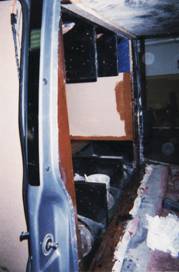
Picture
9
|
Enclosure officially numbered five, not including the redesigns
of the previous enclosures, allowed for the creation of a three half
polygon enclosure that could be installing at a varied distance from the
microphone for testing. The
enclosure allowed sufficient mounting locations for twelve subwoofers
and six amplifiers. Each
subwoofer cone was mounted at a 45Ί parallel to the auto floor.
Each of the straight portions of the polygon arms had two
subwoofers mounted perpendicular to the windshield.
Design of the enclosure came about from analysis of the first
place competitor of the local S.P.L. competition.
Considering that his enclosure build had a low amount of
cancellation issues than all of the other competitor enclosures, he also
had a very high pressure result. His
enclosure had fifteen subwoofers, with five in each half polygon shape.
Number five enclosure only provided four subwoofers in each half
polygon to reduce pressure cancellation. Experimentation
with this versatile enclosure provided answers to a variety of
questions. Enclosure
distance from the windshield, microphone, for 80Hz and 120Hz was solved.
At 80Hz, each of the twelve separate enclosure size seemed to be
prevalent at 1.5 cubic-feet with the reflective rear of the enclosure
located at 72 inches. The
120Hz response prevailed when each of the individual twelve subwoofer
enclosure was provided with a very small amount of air.
Each of the 120Hz enclosures responded with higher S.P.L. when
the enclosure was decreased as it was further from the microphone.
The optimal distance of the enclosure reflective rear, for higher
frequencies, was directly behind, allowed distance, the door jamb.
This enclosure provided new information about resonant frequency
response due to enclosure size, distance from microphone, fiberglass
resin and mat use, and a final lesson which allowed for an increase of
over 5db. The increase for
over 5db was provided due to sealing the air circulation system of the
vehicle and lining the interior of the vehicle with M.D.F. and
fiberglass resin. AIR
TIGHT!!!!! Following the air
tight revolution the van created a ground-breaking pressure recording of
172db. I broke the 170db
mark with 120Hz resonance frequency!!!
|
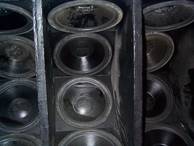
Picture
9
|

Picture
10
|
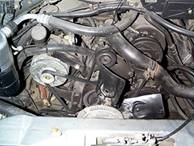
Picture
11
|
After the completion of the vehicle, new information was
introduced to me about the competition rules.
The 120Hz range was not acceptable due to the lack of rumble for
the spectators. After the
disappointment subsided, I change the enclosure and concerted it to a
rumbling and loud sales vehicle that played a variety of music.
The conversion process included an experience with body work and
paint which is information for a different story.
The final pictures of the van without equipment are located
below.
|
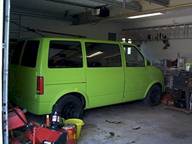
Picture
12
|
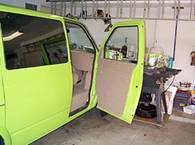
Picture
13
|
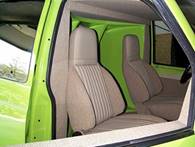
Picture
14
|
|
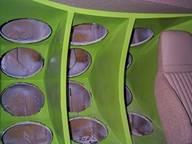
Picture
15
|
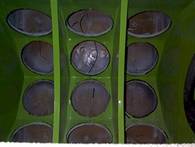
Picture
16
|
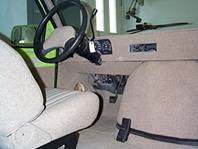
Picture
17
|
|
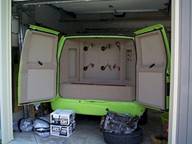
Picture
18
|
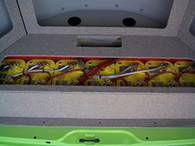
Picture
19
|
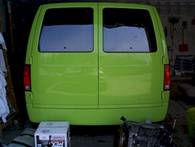
Picture
20
|
Completion of the 120Hz enclosure provided important information
which could have allowed the six V enclosures to surpass all of
the other designs. I did not
receive addition opportunities to critique the design for optimization.
The next sealed S.P.L competition enclosure for fifteen-inch
subwoofers will be a similar reproduction of the six-V at the correct
distance for the frequency and enclosure air space size.
|














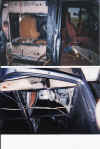
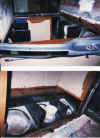


|